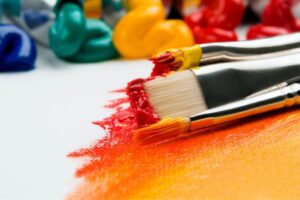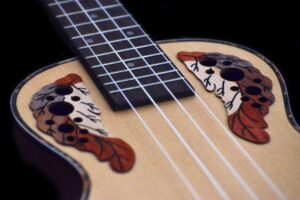The world of music has always been intertwined with artistry and self-expression. For guitar enthusiasts, the instrument can be a canvas for showcasing individuality and creativity.

While guitars come in various stunning designs, some musicians seek to take their instrument customization to a whole new level.
Hand painting a guitar has emerged as a popular means of transforming a standard guitar into a unique work of art. But is it a good idea? Let’s explore that in this article.
Contents
Is Hand Painting a Guitar a Good Idea?
Yes, painting your guitar is a good idea. Hand painting a guitar may be beneficial for a variety of reasons. For starters, it provides a one-of-a-kind chance for self-expression and creativity.
You may personalize your guitar by hand painting it with motifs, patterns, or even elaborate artwork that reflects your personality.
It enables you to make a statement and stand out from the crowd while displaying your individuality and aesthetic sensibility.
Furthermore, hand painting a guitar might help you form a stronger bond with your instrument. You develop a stronger bond with it by investing time and effort into customizing your guitar.
This emotional attachment can enhance your playing experience and inspire you to create music that is truly unique and personal.
Hand painting can also breathe new life into an older or worn-out guitar. If you have a guitar that looks dull or has scratches or dings, hand painting it can give it a fresh and revitalized appearance.
It allows you to transform a tired-looking instrument into a vibrant and visually appealing piece of art.
Moreover, hand painting a guitar can serve as a conversation starter. When you perform on stage or in a band, a hand-painted guitar can capture the attention and curiosity of the audience.
It can spark conversations about your artistic process, the inspiration behind the design, and your overall creative journey.
How to Hand Paint a Guitar
Hand painting a guitar is a rewarding and creative endeavor that allows you to personalize your instrument and uniquely reflect your artistic vision.
If you’re interested in hand painting your guitar, follow these steps to ensure a successful and professional-looking result.
Preparing the Guitar for Painting
Disassembling the Guitar (if necessary):
Before you begin the painting process, assess whether any parts of the guitar need to be removed for easier access or protection.
This might include detaching the neck, pickguard, bridge, or other components. Take time to label and organize the parts to ensure they can be reassembled correctly.
Cleaning and Sanding the Surface:
Clean the guitar thoroughly to remove any dirt, oil, or residue that may affect the adhesion of the paint.
Use a mild detergent and water solution or guitar-specific cleaning products.
Once cleaned, lightly sand the surface with fine-grit sandpaper (around 400-600 grit) to create a smooth and roughened texture for the paint to adhere to. Be gentle to avoid damaging the wood or finish.
Applying a Primer Coat:
To enhance paint adhesion and create a uniform base, apply a primer coat to the guitar’s surface. Choose a primer suitable for the material of your guitar (wood, metal, etc.).
Apply the primer evenly, following the manufacturer’s instructions. Allow it to dry completely before proceeding to the next step.
Designing the Artwork

Choosing a Theme or Concept:
Before you begin the painting process, deciding on a theme or concept for your guitar artwork is important. Consider your preferences, interests, or any meaningful symbolism you want to incorporate.
You could opt for a nature-inspired design, a tribute to your favorite band or artist, an abstract pattern, or any other concept that resonates with you.
Sketching and Planning the Design:
Take the time to sketch out your design on paper or use digital tools to create a mock-up of the artwork.
This will help you visualize how the design will appear on the guitar and make any necessary adjustments before committing to the painting.
Pay attention to proportions, placement of elements, and overall composition. Refine your sketches until you’re satisfied with the final concept.
Selecting Appropriate Paint Colors and Materials:
Once you have a clear design vision, consider the paint colors and materials to bring your concept to life.
Choose high-quality acrylic or enamel paints specifically formulated for use on musical instruments. These paints offer durability, vibrant colors, and better adhesion to the guitar’s surface.
Select a color palette that complements your design and enhances its visual impact.
Additionally, gather the necessary painting materials such as brushes in various sizes, palette or paint mixing trays, water cups for cleaning brushes, and any additional tools or mediums you may need for special techniques or effects.
Experiment with different brushes and techniques to achieve your artwork’s desired textures, gradients, or details.
Remember to consider the paints and materials’ compatibility with your guitar’s surface.
For example, if you have a guitar with a polyurethane or nitrocellulose finish, ensure the paints and finishes are compatible with these surfaces to prevent any potential reactions or damage.
It’s also a good idea to protect the areas of the guitar you don’t want to paint by using masking or painter’s tape to create clean boundaries and avoid accidental paint splatters or smudges.
Painting the Guitar
Acrylic or Enamel Paint:
Choose high-quality acrylic or enamel paint specifically formulated for use on musical instruments. These paints offer durability and vibrant colors.
Consider using a combination of brushes, airbrushing techniques, or even stencils to achieve your desired effects.
Applying the Base Colors:
Start by applying the base colors of your design. Use thin coats of paint and allow each layer to dry before adding subsequent layers.
This will help prevent drips and smears. Apply additional coats as needed to achieve full coverage.
Adding Details and Effects:
Once the base colors are dry, you can add finer details and effects.
This may include freehand painting, blending colors, adding textures, or incorporating intricate designs. Exercise patience and precision during this stage to achieve the desired results.
Finishing Touches and Protective Coating
Applying Clear Coats for Protection and Shine:
Once you have completed the painting process, applying clear coats to protect the artwork and enhance its longevity is essential.
Clear coats act as a protective barrier against scratches, moisture, and UV damage. They also provide a glossy or satin finish, depending on your preference.
Choose a high-quality clear coat specifically designed for use on musical instruments. Polyurethane or acrylic lacquers are commonly used for this purpose.
Follow the manufacturer’s instructions for application, including proper drying times and the recommended number of coats.
Apply the clear coats in thin and even layers, allowing each coat to dry fully before applying the next.
Avoid disturbing or damaging the painted surface while applying the clear coats. Use clean brushes or sprayers to ensure a smooth and even application.
Work in a well-ventilated area to prevent the buildup of fumes.

Curing and Drying the Paint:
After applying the clear coats, allow sufficient time for the paint to cure and dry completely. Follow the drying times specified by the paint and clear coat manufacturers.
It is crucial to exercise patience during this phase to prevent smudging or compromising the finish.
Consider allowing the guitar to dry clean and dust-free, protected from excessive heat, humidity, or direct sunlight. This will help ensure a proper and durable finish.
Reassembling the Guitar (if Disassembled):
If you take apart the instrument during painting, it’s time to reassemble it now that the paint and clear coatings have fully cured and dried.
Reattach any removed components, such as the neck, pickguard, bridge, or other hardware, with care. Also, ensure you take special care of the line and fasten them appropriately.
Additionally, check that all screws, bolts, and other fasteners are properly fastened. Make sure that all electrical connections have been correctly reconnected and are operational.
Once the guitar has been completely fixed together, you may begin stringing it and tuning it to your chosen pitch. However, it is recommended that to improve the tone and playability of your instrument, use new strings.
See also: Post Hardcore vs. Metalcore – Comparison
Takeaway
The decision to hand paint a guitar boils down to the individual’s passion for art, music, and creativity.
It is undoubtedly a good idea if one is willing to invest time and effort into creating a unique instrument that resonates with their soul.
So, if you are willing to embrace the journey of transforming your guitar into a musical masterpiece, then hand painting a guitar is a resounding and worthwhile endeavor.






